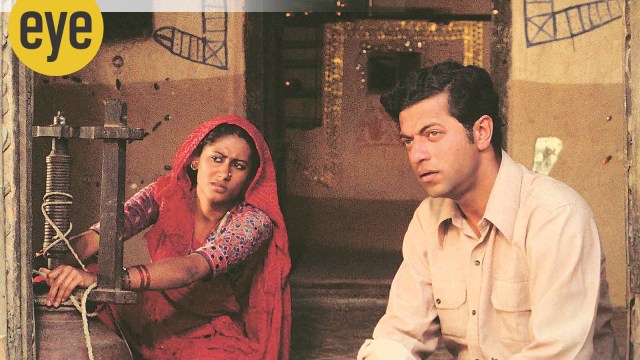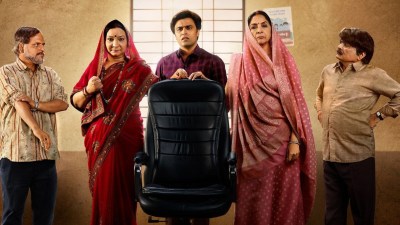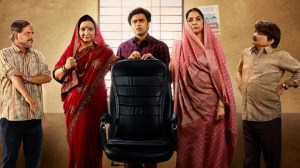- India
- International
How Shyam Benegal’s Manthan, to be screened at Cannes, was one of the earliest examples of a crowdfunded film
Nearly half a century after Shyam Benegal’s Manthan released, its freshly restored print will be shown at Cannes this month and in Indian theatres later.
 Shyam Benegal's Manthan will be screened under the Cannes Classics selection at Cannes 2024. (Photo: Film Heritage Foundation)
Shyam Benegal's Manthan will be screened under the Cannes Classics selection at Cannes 2024. (Photo: Film Heritage Foundation)During the upcoming edition of Cannes Film Festival (May 14-25), delegates will watch two very differently produced Indian films. While Payal Kapadia-directed All We Imagine As Light, which is selected for its competition section, is a France, India, Luxembourg and Netherlands co-production, Shyam Benegal-directed Manthan (1976) is the earliest example of a film financed by crowdsourcing as 500,000 farmers, who were members of the Gujarat Co-operative Milk Marketing Federation Ltd, contributed Rs 2 each.
After a year-long restoration of the Manthan print, the film will be screened under the Cannes Classics selection, which was created 20 years ago to showcase classics, restored prints and documentaries. Other films in the category include Charles Vidor-directed Gilda (1946); Wim Wenders’s Palme d’or winner Paris, Texas (1984); Akira Kurosawa’s Seven Samurai (1954); Tsui Hark’s Shanghai Blues (1984); and Robert Bresson’s Four Nights of a Dreamer (1971).
Manthan has been restored by Film Heritage Foundation (FHF) at Prasad Corporation’s studios in Chennai, and L’Immagine Ritrovata Laboratory, in association with Gujarat Co-operative Milk Marketing Federation Ltd. The film was restored using the best surviving elements: the 35 mm original camera negative preserved at the NFDC-National Film Archive of India, while the sound was digitised from the 35 mm release print, preserved at FHF. Its Cannes screening is scheduled to be held in the presence of actor Naseeruddin Shah, the family of actor Smita Patil, producers of the film and Shivendra Singh Dungarpur, Director, Film Heritage Foundation on May 17 evening at Buñuel Theatre.
This was Benegal’s third directorial outing after the much-acclaimed Ankur (1974) and Nishant (1975), which was selected to compete for the Palme d’Or at the 1976 Cannes Film Festival. Continuing with Benegal’s exploration of social realism, Manthan examines the complex realities of a village – caste system, class conflict and gender dynamics.
 On the sets of Manthan. (Photo: Film Heritage Foundation)
On the sets of Manthan. (Photo: Film Heritage Foundation)
Benegal thought of making the feature film on this subject after he had made two documentaries on Amul’s success in procuring and widely distributing milk. The legendary director wanted to share this success story with a wider audience. Though Verghese Kurien, the father of the White Revolution, said that there was no money to fund a movie, he later came up with a unique idea, which will later be known as ‘crowdfunding’.

Recounting the movie’s making, Benegal said: “Kurien told the (milk) collection centres that when they (farmers) come for their daily morning and evening collection, ask them not to take Rs 2 and they can all become producers of a film.” Benegal believes that Manthan is a reminder of “the power of cinema as a vehicle of change”, as well as Kurien’s legacy. “Govind Nihalani (Manthan’s cinematographer) and I have been following the progress of the restoration closely. It is wonderful to see the film come back to life almost like we made it yesterday,” Benegal said.
The story of Manthan, though inspired by Kurien, is not centred around him. Instead, it takes an incisive look at the challenges involved in achieving unity in a society divided on economic and caste lines. Manohar Rao (Girish Karnad) and his team, which features characters played by Mohan Agashe and Anant Nag, have to navigate the conflict between the upper-caste sarpanch (Kulbhushan Kharbanda) and hot-headed Bhola (Naseeruddin Shah), a Dalit villager, before they can set up a cooperative society. Even as Manohar tries to resolve the differences and unite the villagers, he is fascinated by the feisty Bindu, played by incandescent Smita Patil.
Vijay Tendulkar’s screenplay and dialogues by Kaifi Azmi capture the social realities. Its timeless music composed by Vanraj Bhatia, especially the song Mero gaam katha parey, sung by Preeti Sagar, remains popular even today. Dungarpur says, “Manthan’s restoration was on our wish list for years as Shyam Babu is one of India’s most venerated filmmakers whose early films were iconic in India’s Parallel Cinema movement. Almost half a century later, the power of the narrative and the compelling performances of the actors, especially Smita Patil, remains undiminished.” The FHF has previously premiered restored versions of Thamp̄ and Ishanou at Cannes Film Festival in 2022 and 2023, respectively.
The triumph of Manthan lies in the fact that it does not show the city-bred officials fix the villagers’ problems. The villagers, led by Bhola, figure out their way and run the society. Shah recalls, “I started my career as an actor with Nishant followed by Manthan. Manthan was a runaway success when it was released almost 50 years ago. I remember during its shooting, I lived in a hut, learnt to make cow dung cakes and milk a buffalo. I would carry the buckets and serve the milk to the unit to get the physicality of the character.”
Also Read | From Pather Panchali and Lagaan to All We Imagine as Light: India stars at Cannes
Shot by Nihalani, who was Benegal’s frequent collaborator in the ’70s, the film has a lyrical quality thanks to his treatment of light, shadow and colour. For the cinematographer-turned-director being involved in the restoration has been “an emotional experience”. “It has taken me back to 1976 when the entire unit lived like a family in the village of Sanganva in Gujarat for 45 days during the shoot. The shooting was challenging because we had to use a patchwork of different film stock– Eastman and Gevacolor besides Kodak, 35 mm for the film and 16 mm for the film within the film,” says Nihalani. The 4k version of Manthan will subsequently be screened in Indian theatres.
Buzzing Now
May 28: Latest News
- 01
- 02
- 03
- 04
- 05






































